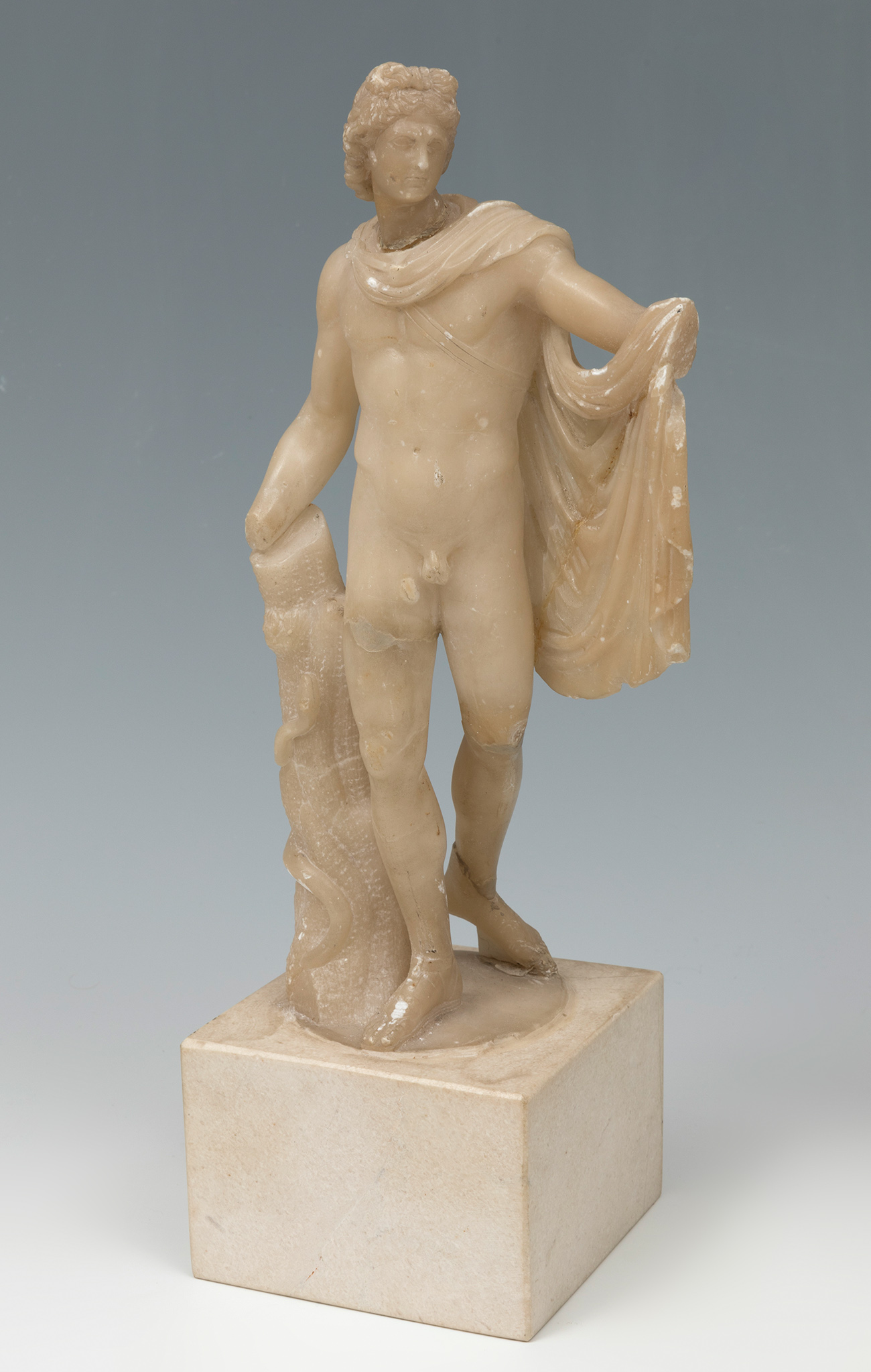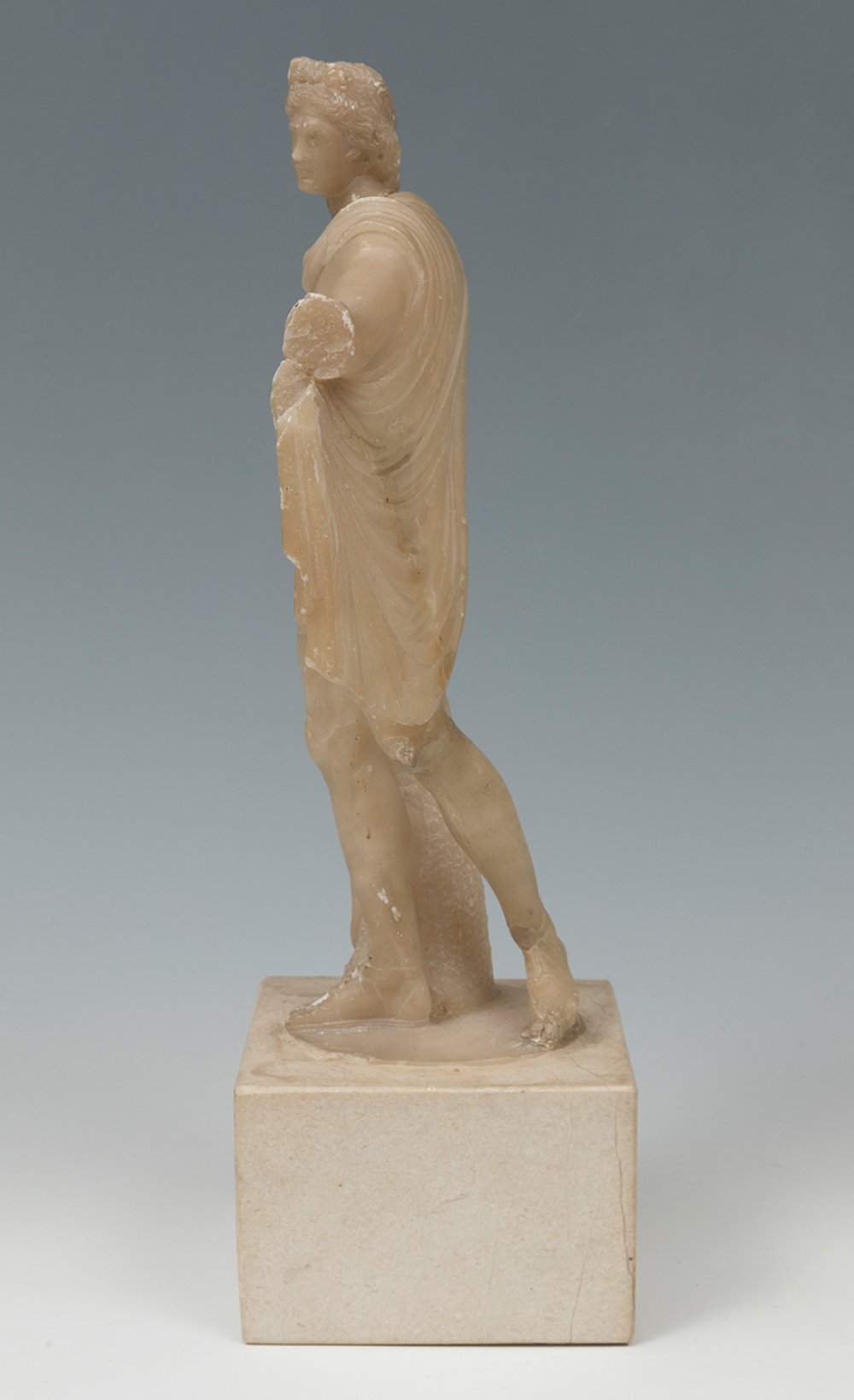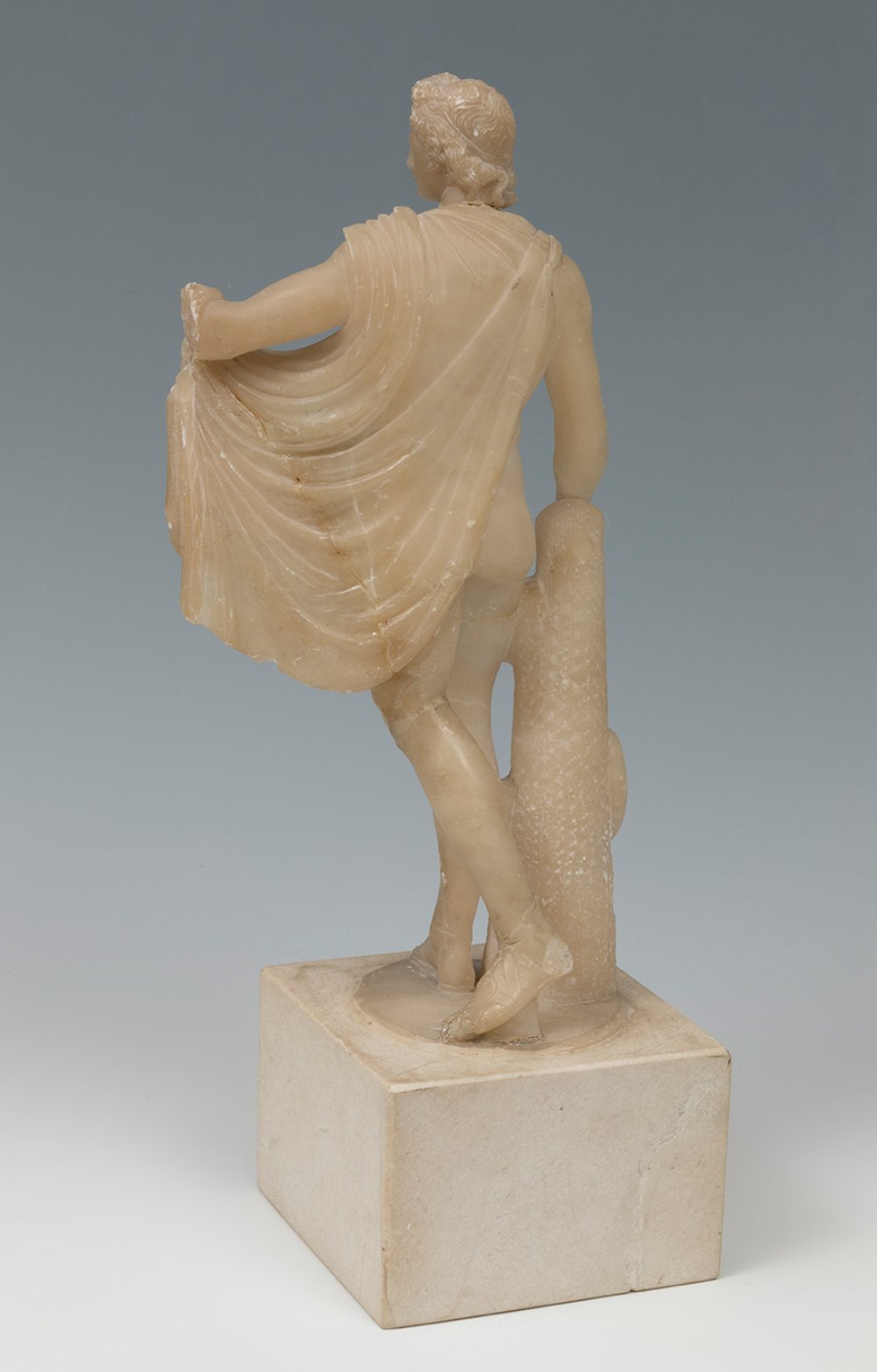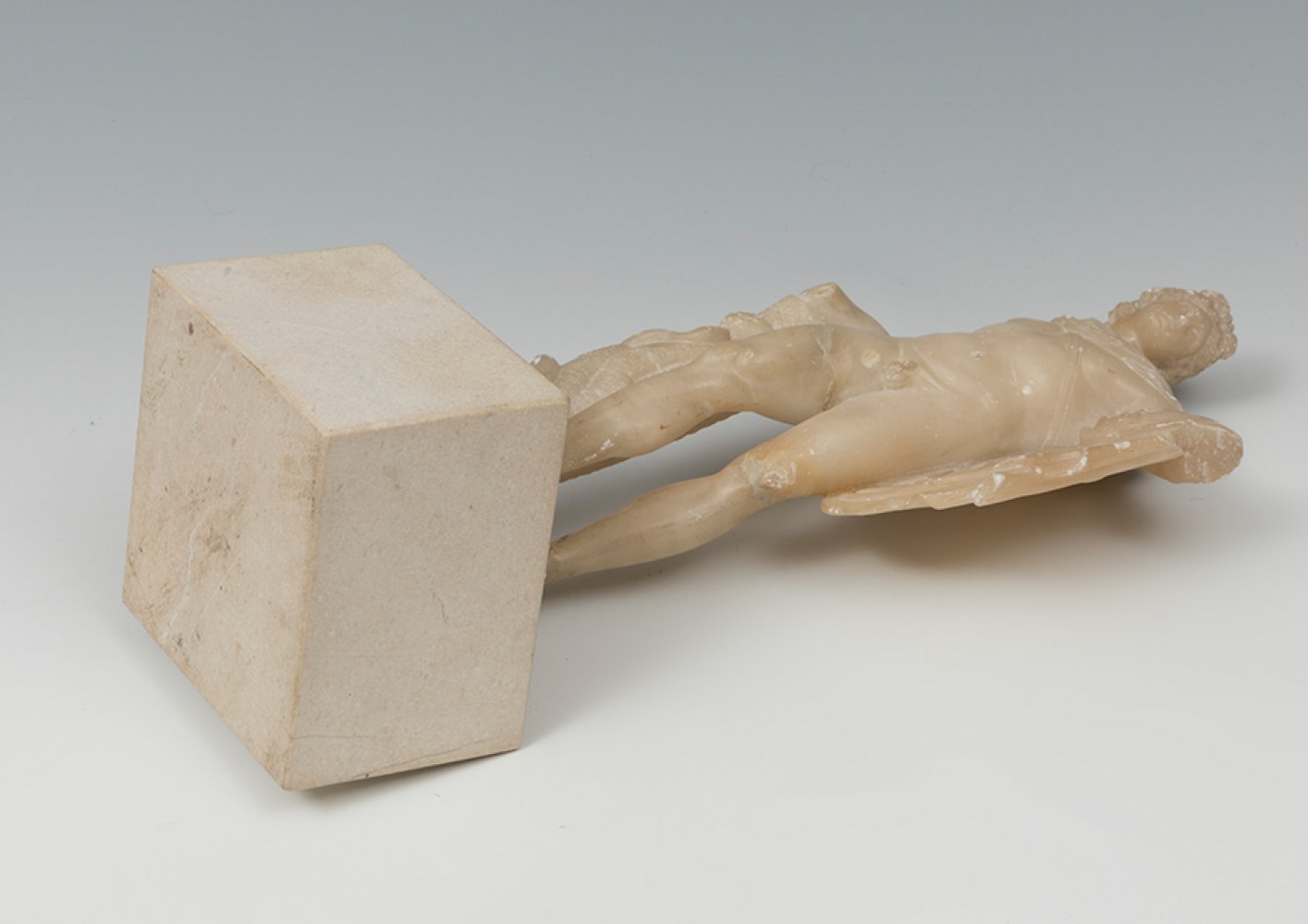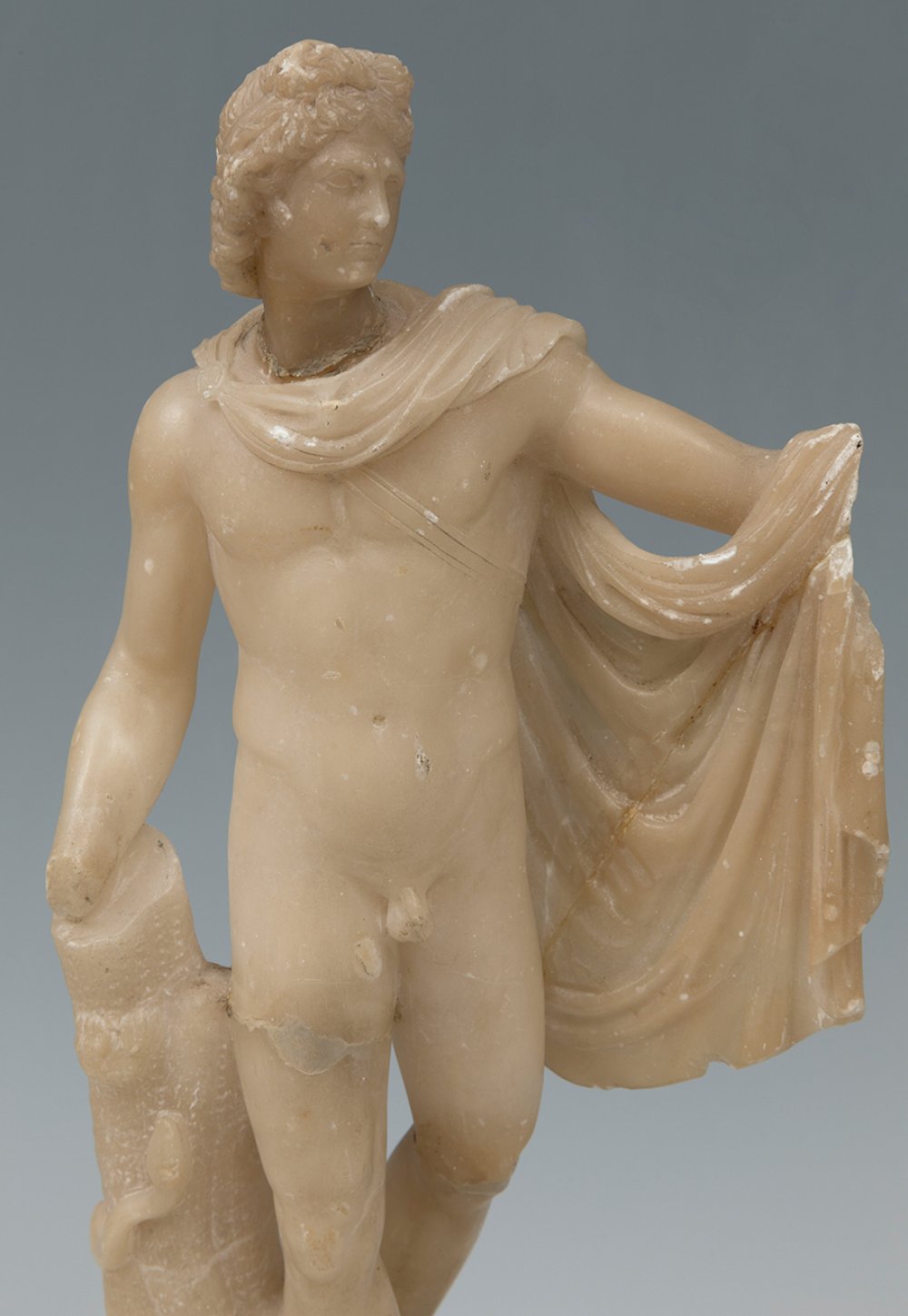19
Italian school; 19th century."Apollo of the Belvedere".Carved alabaster.It presents faults.
"Apollo of the Belvedere".
Carved alabaster.
It presents faults.
Measurements: 35 x 16 x 11 cm.
19th century reproduction of the Belvedere Apollo, a work attributed to the Greek sculptor Leocares (350-300 BC). Although the original has been lost, an ancient Roman copy has survived, discovered at the end of the 15th century and exhibited in the Cortile del Belvedere in the Vatican from 1511. In fact, it was the first important ancient piece acquired by Giuliano della Rovere, the future Pope Julius II, and is still in the collection of the Vatican Museums today. The work acquired great fame from the 15th century onwards, and for a long time was considered an ideal of male physical perfection, as well as one of the most precious relics of classical antiquity. The sculpture was widely disseminated, both through copies and engravings, until it became one of the symbols of Western civilisation. However, from the mid-19th century it gradually lost prestige, and by the beginning of the 20th century it had come to be regarded as a creation without expression. However, its artistic merit has been widely recognised since then.
The term "Grand Tour", which first appeared in Richard Lassels' "Le Voyage d'Italie", was used to define the long journey through Europe, especially Italy, which was usually undertaken by young British aristocrats from the 17th century onwards, but especially throughout the 18th and 19th centuries. The purpose of the journey was for young people to become acquainted with the art and culture of mainly France and Italy, to admire classical art at first hand, to learn or improve their knowledge of languages, and to establish contacts and relations with the cultural and political elites of these countries. Travellers were often looking for pieces with which to start their own art collections, objects to take back to their places of residence as souvenirs. For this reason, workshops specialising in the replication of Roman pieces, both in bronze and marble, sprang up, some of which acquired a great reputation.
"Apollo of the Belvedere".
Carved alabaster.
It presents faults.
Measurements: 35 x 16 x 11 cm.
19th century reproduction of the Belvedere Apollo, a work attributed to the Greek sculptor Leocares (350-300 BC). Although the original has been lost, an ancient Roman copy has survived, discovered at the end of the 15th century and exhibited in the Cortile del Belvedere in the Vatican from 1511. In fact, it was the first important ancient piece acquired by Giuliano della Rovere, the future Pope Julius II, and is still in the collection of the Vatican Museums today. The work acquired great fame from the 15th century onwards, and for a long time was considered an ideal of male physical perfection, as well as one of the most precious relics of classical antiquity. The sculpture was widely disseminated, both through copies and engravings, until it became one of the symbols of Western civilisation. However, from the mid-19th century it gradually lost prestige, and by the beginning of the 20th century it had come to be regarded as a creation without expression. However, its artistic merit has been widely recognised since then.
The term "Grand Tour", which first appeared in Richard Lassels' "Le Voyage d'Italie", was used to define the long journey through Europe, especially Italy, which was usually undertaken by young British aristocrats from the 17th century onwards, but especially throughout the 18th and 19th centuries. The purpose of the journey was for young people to become acquainted with the art and culture of mainly France and Italy, to admire classical art at first hand, to learn or improve their knowledge of languages, and to establish contacts and relations with the cultural and political elites of these countries. Travellers were often looking for pieces with which to start their own art collections, objects to take back to their places of residence as souvenirs. For this reason, workshops specialising in the replication of Roman pieces, both in bronze and marble, sprang up, some of which acquired a great reputation.
8th November - 19th & 20th Century Arts
Sale Date(s)
Venue Address
General delivery information available from the auctioneer
Setdart offers Worldwide shipping
PICK UP IN ROOM: You can come and pick up your lots in our offices (Barcelona, Madrid or Valencia). At the moment of the withdrawal, you will be able to accept the current conditions of the lot by means of a document that you will sign.
YOU CAN SEND ANOTHER PERSON TO PICK UP: This person must present a signed authorization that you can find in our web page by accessing from BUY AT SETDART- LOGISTICS-DOWNLOAD AUTHORIZATION DOCUMENT. You can also send an e-mail with the requested data in AUTHORIZATION DOCUMENT to admin@setdart.com
Important Information
25% buyer´s premium
OR
21% buyer´s premium at www.setdart.com
Terms & Conditions
The maximum period to pay the lots is 7 working days. You can pay either via bank transfer or with credit card through our platform www.setdart.com (we only accept VISA or Mastercard).
BUYER´S PREMIUM: 22% Hammer price + 21% VAT from the buyer´s premium
If your piece has more than 100 years, our Ministry of Culture requires an export certificate in order for the piece to leave the country. Note that if the piece goes inside the EU, there is no cost for the export certificate. If the piece goes outside the EU, there is a cost for the export certificate. You can find more information in our Ministry of Culture website: https://www.culturaydeporte.gob.es/en/cultura/patrimonio/exportacionimportacion/exportacion/tasas.html
INQUIRIES: admin@setdart.com
Setdart guides you through the entire process, from the time of award to the day you receive your lot. Our logistics team will be happy to manage your transport, and will advise you on the best shipping method with professionals from the sector used to handling works of art and jewelry.
WE OFFER WORLDWIDE DOOR TO DOOR SHIPPING
PICK UP IN ROOM: You can come and pick up your lots in our offices. At the moment of the withdrawal, you will be able to accept the current conditions of the lot by means of a document that you will sign.
YOU CAN SEND ANOTHER PERSON TO PICK UP: This person must present a signed authorization that you can find in our web page by accessing from BUY AT SETDART-LOGISTICS-DOWNLOAD AUTHORIZATION DOCUMENT. You can also send an e-mail with the requested data in AUTHORIZATION DOCUMENT to admin@setdart.com
SETDART IS NOT RESPONSIBLE FOR THE STATE OF THE PARTS ONCE THEY LEAVE OUR FACILITIES. MRW SHIPMENTS: Once the payment is made, your lot will be packed for shipment, the logistics department will send you an e-mail notifying you of the day it leaves our warehouse, changes of address cannot be made after receiving this e-mail.
INSURANCE INCIDENTS: Coverage for the value of the auction up to 3000 ? per shipment, if the value of the auction is higher, Setdart will send you a quote including the additional insurance. The insurance company WILL NOT BE RESPONSIBLE FOR THE SHIPMENT THAT EXCEEDS THAT AMOUNT AND IS NOT FULLY INSURED. MRW INCIDENTS: Maximum notification 48 hours after receipt, after which the insurance company WILL NOT BE RESPONSIBLE AND NO CLAIMS WILL BE ACCEPTED.
E-MAIL LOGISTICS: logistica@setdart.com
PICK UP YOUR MESSAGES: You can send your own messaging, prior notice via e-mail that your shipment is ready, please note 3 or 4 days in advance. This type of shipment is packaged so Setdart will provide you with a quote.
EXPENSES FOR STORAGE: We inform you that if the purchased lot is not picked up within a month, you will be charged 30€ per week per lot. Setdart Online S.L., owner of the web site "setdart.com", "setdart.net" and "setdart.org", acts as a company of Spanish nationality inscribed in the Volume 36955, sheet 182, page B-293056 of the Mercantile Registry, with registered office at Calle Aragó













